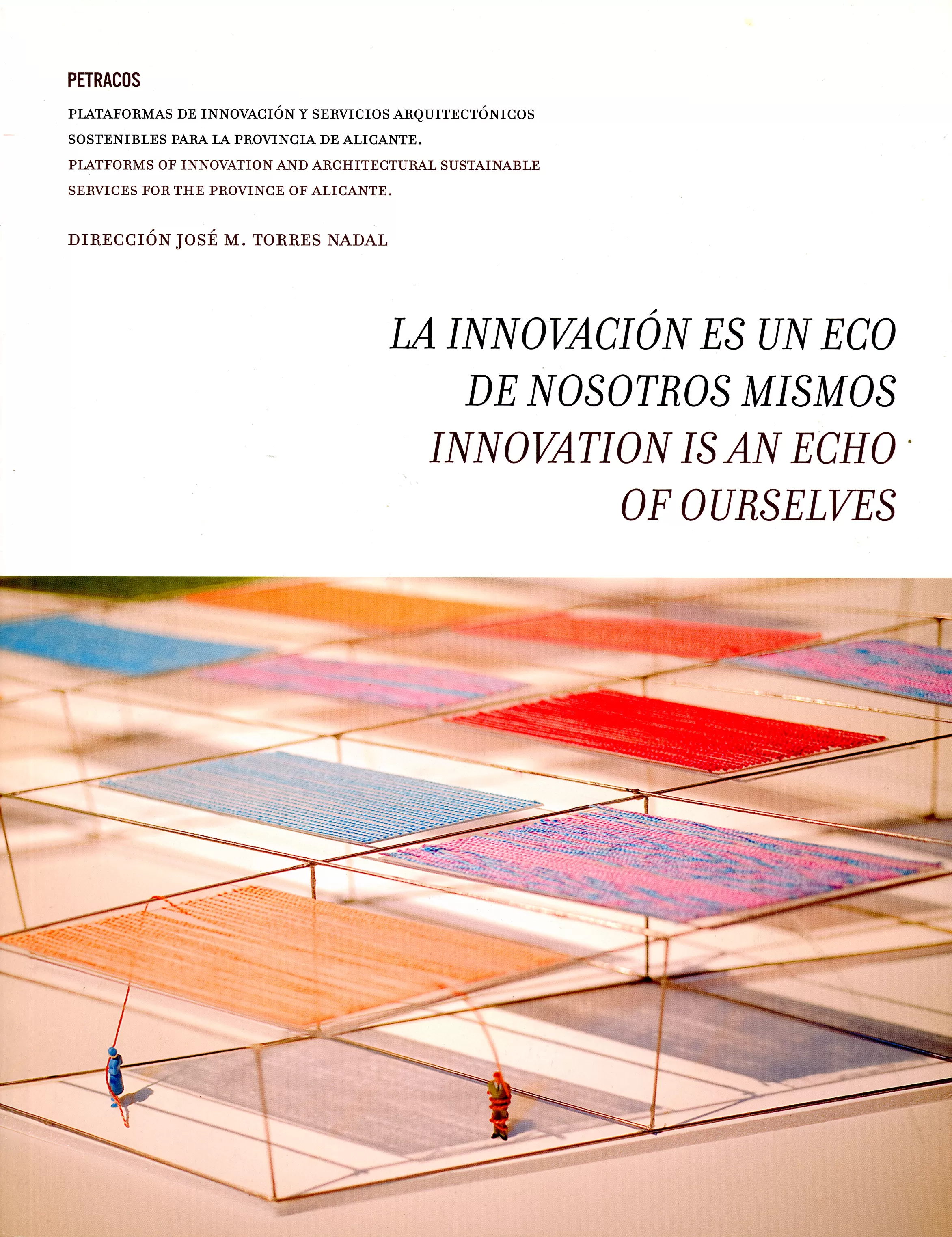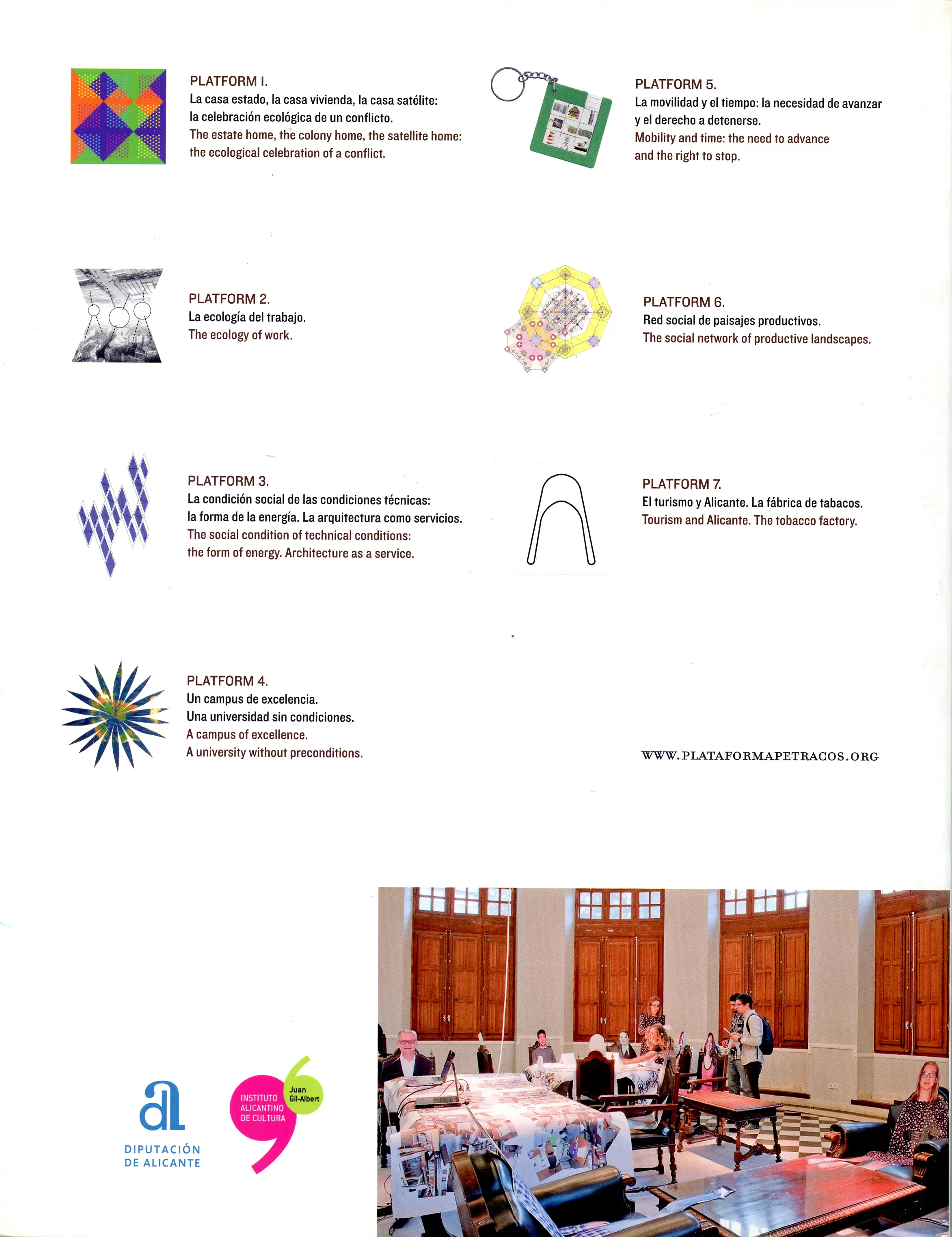Publications
La innovación es un reflejo de nosotros mismos. Plataforma Petracos.
Proyecto Colectivo expuesto en el Palacio de la Diputación de Alicante.2011
Design: Pep Sempere.
Writings: José M. Torres Nadal, Juan Urrutia, Enrique Nieto, ANdrés Jaque, Remedios Zafra, Juan Freire, Teresa Lanceta Aragonés and Tomás Amat Guarinos.
Writings
- Epilogue of the Petracos Platform - Teresa Lanceta
TO THOSE WHO MOVE NIMBLY
1. DWELLINGS AND HOMES
1.1. Everyone's house
To my father
Where children grow and siblings play
Where there is always something to nurture
Where there is always something to share
Where "the dice are fair"
Where self -absorption happens in the plural1.2. Elasticity and dwelling
The neighbours of the traditional family are single-parent homes, couples with children from different parents, groups of friends or students or even people who have no ties beyond those of sharing the same living space. Despite their many differences, they are all contained in identical structures that are almost fixed within the same walls. Not only do these people move, but everything around them moves as well, jobs come to an end and new ones come up in other cities, students return, or go away on an Erasmus exchange, the married get divorced and the divorced remarry. Everything moves in the building except the building itself, unmoved by the unexpected synergies and the disparate needs of its inhabitants, whose lives are increasingly permeable. The flexibility of the new behaviours cuts across architectural boundaries, bringing the workplace to the home while "home" may well be a restaurant where owners and guests are friends and where one can chat. An elasticity that brings the home to the street and allows the street to come into the house, the public space to reach the inside, and the private space to extend beyond it.
1.3. The fractured house
To Olga Diego
The fractured house is a mirror that has banished its dwellers.
But it hides something, alien to the others, which it wants seen.
There is still time to fight!1.4. Constructive disproportion
Why is it that in the construction and destruction of the Tower of Babel there were bricks, a disproportion in measures, and a lack of understanding among people?
nobody homeless = NOBODY HOMELESS
2. MEASURING WORK
How much of the work of others is in your life? How much of your work in theirs? If we could measure... how much work is exchanged, how much is needed for the common good, how much for solidarity, how much is usurped, robbed, how much annihilated and how much wasted. If we were to measure the benefits (or the harm), the fate and the consequences of work beyond the charts and calculations of business firms.
The adaptation to a future of minimum environmental costs demands an extraordinary creative effort. Small entrepreneurial nodes, which can move nimbly and compound the contributions of all of their members, never fail to show their efficiency. Located in peripheral (ex-centric) spaces, such as garages, industrial warehouses, even in homes, these freelance inventors full of imagination craft important technological advances with scarce means. Thank you!
The behaviour of some innovators as greedy-entrepreneurs-businessmen hampers the development of technological investigations, detracting considerably from the social and environmental sustainability of the projects, something that contradicts the creative and transformational spirit of science. In the first half of the zoth century, some of the most salient scientists were led to the creation of the first atomic bomb not out ·of financial greed, but of the desire to advance in their own investigations; eventually they regretted it deeply, for nothing justified the deaths and destruction that followed. Will greedy innovators ever regret not having acted in pursuit of the common good?
Eking out a living. Said of an inadmissible practise when ample and (or) specific sectors of the population (in some instances, entire countries) do not have access to employment, and therefore have no choice but to "eke out a living" in an improvised and precarious manner. However, at given times, it can be an enriching experience if it is tackled with a high degree of inventiveness and seeking change.
In their originality and creative dissidence, those that eke out a living are niche hunters that expand the world, its sensibility, and its critique.
3. INNOVATE
INNOVATE is action.
INNOVATE is ensuring that one's own benefit contains implicit the benefit of others.
INNOVATE is to obtain from work both a personal return and a common good.
4. THE PLACE OF KNOWLEDGE
Is it not strange that the public space ‑space of public property, domain and use‑ can be used for private interests that go against the common good?
The public space is where the I becomes a we and individual actions become collective. Where private spheres coexist, encounters converge, and transactions can happen. Where the persons of the verb conjoin. It is the substrate of our personal life and our community life. It is internal and external, and the bridge that joins both dimensions is conformed by relationships and interaction.
It is sharing, assuming responsibility, exchanging, giving, demanding, choosing, doing and transforming... It is recycling, saving energy and water. It is "consuming less to live better".
Public space is that which we enjoy if we create it, which we have if we defend it. It is the place of knowledge. And knowledge is plural.
5. THE TIME OF IMAGES, MESSAGES AND ART
5.1 Images: Variable Time
A few Vietnamese children run for their lives, burnt by napalm. Whoever has seen these photographs has not been able to forget the suffering, the horror and the profound criminality of the act. An image is worth a thousand words.
Today we see the tragedy in Japan on television or on the web through videos and slideshows that explain the before and after of the catastrophe; among the rubble, a nuclear power plant. In contrast to the photograph by Nick Ut, these broadcast documents are not icons because motion detracts from their iconic power, yet it adds other components. They also do not have the feel of face-to-face communication of the scream of the Vietnamese girl, but rather refer to anonymity, to a vast and impersonal plural in which society is submerged; they seem to tell us: it could have happened to anyone. Witness accounts of the tragedy reveal the defeat of human hubris against nature, call for help, and cast a reflection on the international community: the future demands changes.
Photographs, documentaries and videos are unidirectional and mark a time and space that diverges from those of the spectator. There is a deceleration, a delay. This is variable time.
5.2. Messages: Instantaneous Time
Are messages worth more than images? Yes, if what we seek is the immediate, the plural and the multidirectional.
Millions of text messages, electronic mails and network messages have been sent recently in Egypt and in many other dictatorships of the Arab world. They are not petitions nor are they prayers, but acts stemming from a will to make changes. They multiply exponentially, putting in touch an extensive community for joining, organising and carrying out these exceptional "uprisings", peaceful and unexpected. It is the self added to the selves of others, in juxtaposition, one by one, forming a whole, integrated rather than consumed. It is instantaneous time, a time that is shared through technology and interactive communications.
5.3. Art: Invariable Time
What is most valuable in invariable time? Knowledge and art, without a doubt.
6. PRODUCTS. NOT FOR ME
For those who have no access to them, food products are basic commodities; for the rest of us, they are a responsibility. From product to commitment, from consumer to participant.
We are groves of almond trees, terraces of cherry tree, orchards and vineyards.
7. INTIMACY AND TOURISM
Privacy is a right that protects the subject from unwanted external intrusions. It encompasses personal and professional relationships, confidential spaces and documents; it has specific limits and it is regulated, but... intimacy... what is intimacy in such changing times?
Intimacy does not have a physical manifestation. Itis intangible and as such deserves special attention. It alludes to what we are, to feelings, to culture, to beliefs and to the freedom to choose what to show the others of oneself and how to do it, but it is slippery and changes over time, from culture to culture and from religion to religion. It has a permeable firmness. It is founded on collective tacit agreements that are constantly revised, and we live in the midst of these commitments, transformations or frictions. Intimacy is a common good in which we develop. It is there, in this sphere, individual and collective, private and public, where we advance our knowledge, freedom, and respect.
Travels, the flow of peoples, multiply the encounters, demanding decisions and changes from all parties. Emigration travels with much physical and emotional baggage, but transforms both and lightens their burden. Tourism is another form of travel, accelerated and joyous. We are all, in a way, its children, who travel to faraway lands thanks to low costs, and those in the receiving countries, or those who relax absentmindedly while sunbathing in the beach, the prudish and the uninhibited, the old and the young, the embarrassed and the infatuated, all under a tacit pact that establishes the highest degree of intimacy in the minimum personal space (a towel and a sunshade). Avow that makes possible, under the pressures of overcrowding, for almost naked individuals who do not know each other to respect the privacy of the other. It is the same berated "sun-and-beach" tourism that helped a society fed up with dictatorship to "strip itself" and contributed to social development, although it was and still is a pretext for economic predators.
But we no longer are, neither us nor those who visit us, in the time of private constructions, because in the deepest intimacy of ours and theirs stirs a desire which is increasingly becoming a conviction: the future of tourism resides in the respect for nature and in knowing and encountering the other.
(Translation by Lambe & Nieto)

